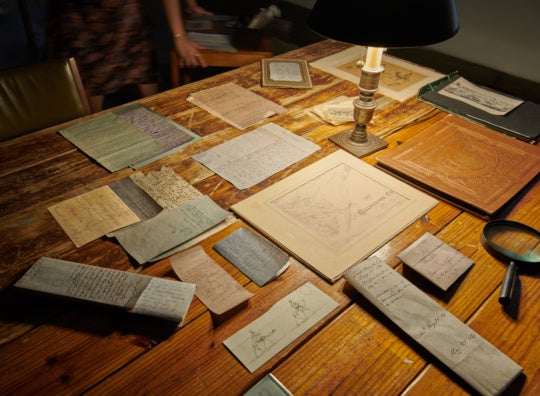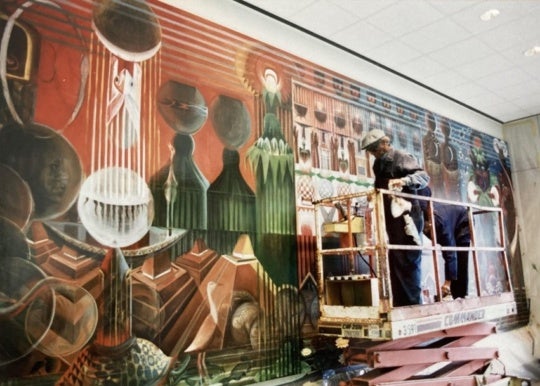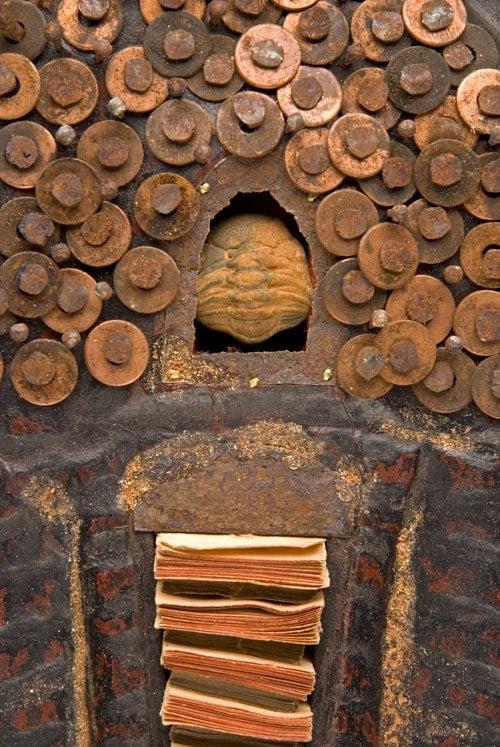
Best known as a pioneer of American Regionalism during the late 1920s and 1930s and, of course, for his role in mentoring Jackson Pollock, Thomas Hart Benton famously portrayed life in the heartland. His celebrated murals, populated by industrious and heroic figures, reflect pride in American culture and industry, and promote an artistic movement that’s our nation’s own.
“Thomas Hart Benton, Lonesome Road: Works from the Estate,” though, provides a much more complete and complex view of the artist’s practice. The show’s 26 prints, drawings, and paintings, on view at Alan Avery Art Company through January 25, illustrate Benton’s engagement with figuration as well as abstraction, his stylistic integration of movement and stillness, the persistent presence of a European modernist influence, and his particular attention to portraying the dignified lives of and cruelty toward African Americans in the Southern and Plains states, a subject especially relevant to Atlanta’s history.
As a young artist, the Missouri native spent two years in Paris (1911-1913), absorbing cutting-edge European trends in color and form by artists such as Cézanne and Matisse, the Cubists and Synchronists. But after serving as a draftsman in the Navy during World War I, his experience with realistic, representational rendering dramatically altered his content and style. Benton became committed to figurative subjects celebrating rural, small-town American life during the Depression era. While this shift in his practice is typically understood as an about-face and a rejection of the European avant-garde, the sway of those artists had already affected him and would carry on in his distinct style, as is evident in this show.

14¼ by 16 inches.
The works on view range from studies—some for the murals he’s most closely identified with—to completed works, and represent the breadth of Benton’s career, from the 1920s to the 1970s. The subjects, however, are consistent: scenes of hard-working, reverent African American workers planting crops, driving cattle, hoisting heavy loads, attending church. While naturalistically rendered and typically quiet in tone, the motion Benton injects into the scenes—rolling hills, creeping skies, and pulsating muscles—activates the images, complicates the subjects, and recalls the very modernist tendencies he claimed to refuse.
In the lithograph Planting (1939), Benton depicts a man handling a horse plow through open fields with a woman, casting seeds from a bucket, treading behind. The scene of ordinary farm life is imbued with a nobility and serenity that defies Benton’s typical sense of movement, an incongruity that complicates the easy scene. The swelling fields and plowed rows produce a repeating pattern of horizontal lines that bridges the foreground and background and circulates the viewer’s eye. The action occurs at the center of the image, flowing from left to right and halving the print. A single craggy tree and wisp of clouds, both centered in the distance, divide the image vertically and carry attention upwards. The manner in which Benton constructs his composition so that the viewer’s eye is constantly moving, circling, recalls Matisse’s full compositions comprising disparate parts connected through graceful lines.

While all of the works involve figures, Benton’s style surprisingly slips toward abstraction in the two, provocative oil paintings included in “Lonesome Road.” In the 8-by-10¾-inch Chain Gang (1928), African American laborers bearing pick axes occupy the foreground while two white males watch over them, one with rifle in hand. The figures are composed of flat, broad strokes of grays and blacks, blues and browns. In addition to limiting the color palette, Benton has left out identifying features and details; the image nearly appears a sketch.
With further attention, the seemingly nondescript, small painting emerges as a gem. Close looking and slight shifting in one’s stance reveal a shiny halo surrounding the figures. The tin surface upon which Benton painted is mostly concealed by the opaque neutral colors but at moments peeks through, injecting bright spots into the dismal scene. What’s more, Benton painted on both sides. With some assistance from Avery’s helpful staff, one is able to catch a glimpse of two separately matted images that appear on the verso: one of a larger group of laborers in similar gray tones and the other a more colorful and very striking depiction of a house. The tin surface is even more evident in these. It is unfortunate that the installation doesn’t allow for simultaneous viewing of both sides.

The other oil painting included in the show, larger and painted on board, shares qualities with Chain Gang, qualities one does not typically associate with Benton’s practice. Violence (n.d.), depicting an interior space inhabited by a mess of figures in a chaotic brawl, reveals an emphasis on brushwork and so little detail that the painting tends toward abstraction. With more harsh angles and straight edges than appear in most of the other works, an unusual composition that offers a scattering of focal points, and a style in which the paint handling dominates over any resolved image, this painting evokes Cézanne and Cubism.
Benton’s subtle assimilation of European modernist elements—despite his insistence otherwise—enabled him to communicate his distinct Regionalist perspective. “Lonesome Road” reveals Benton’s openness to artistic influences, his balance between oppositions, and his personal social consciousness in subject choice and style, contributions that continue to provide artists with many important lessons.
Emily Taub Webb is a professor of art history at the Savannah College of Art and Design, Atlanta.





